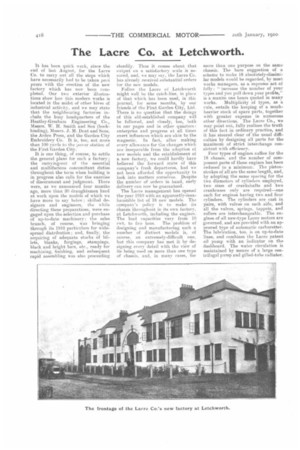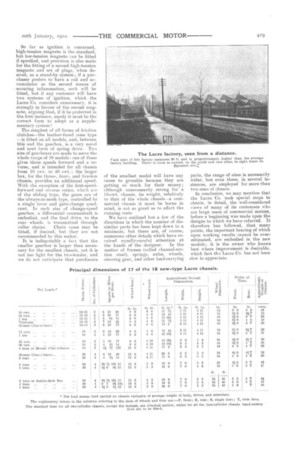The Lacre Co. at Letchworth.
Page 6

Page 7

If you've noticed an error in this article please click here to report it so we can fix it.
It has been quick work, since the end of last August, for the Lacre Co. to carry out all the steps which have necessarily had to be taken pa ri pasta with the erection of the new factory which has now been completed. Our two exterior illustrations show how this modern works is located in the midst of other hives of industrial activity, and we may state that the neighbouring factories include the busy headquarters of the Heatley-Gresham Engineering Co., Messrs. W. H. Smith and Son (bookbinding), Messrs. J. M. Dent and Sons, the Arden Press, and the Garden City Embroidery Co. It is, too, not more than 100 yards to the power station of the First Garden City.
It is one thing, of course, to settle the general plans for such a factory; the carrying-out of the essential and multifarious concomitant duties throughout the term when building is in progress also calls for the exercise of discernment and judgment. There were, as we announced four months ago, more than 30 draughtsmen hard at work upon the models of which we have more to say below skilled designers and engineers, the while directing these preparations, were engaged upon the selection and purchase of up-to-date machinery ; the sales branch, of course, was bringing through its 1910 particulars for widespread distribution ; and, finally, the acquiring of adequate stocks of billets, blanks, forgings, stampings, black and bright bars, etc., ready for machining, finishing, and subsequent rapid assembling was also proceeding steadily. Thus it comes about that output on a satisfactory scale is assured, and, we may say, the Lacre Co. has already received substantial orders for the new models.
Follow the Laere of Letchworth might well be the catch-line, in place of that which has been used, in this journal, for some months, by our friends of the First Garden City, Ltd. There is no question that the doings of this old-established company will be followed, and closely, too, both in our pages and in other quarters : enterprise and progress at all times exert influences which are akin to the magnetic. In fact, after making every allowance for the changes which are inseparable from the adoption Of new models and the establishment of a new factory, we could hardly have believed the forward state of this company's fresh departores, had we not been afforded the opportunity to look into matters ourselves. Despite the number of orders in hand, early delivery can now be guaranteed.
The Lacre management has opened the year 1910 with an apparently-inexhaustible list of 18 new models. The company's policy is to make its chassis throughout in its own factory, at Letchworth, including the engines. The load capacities vary from 10 rwt. to five tons. The problem of designing and manufacturing such a number of distinct models is, of course, an extremely-difficult one, but this company has met it. by designing every detail with the view of its being used on more than one type of chassis, and, in many cases, for
more than one purpose on the same chassis. The bare suggestion of a scheme to make 18 absolutely-dissimilar models would be regarded, by most works managers, m a supreme act of folly : " increase the number of your types and you pull down your profits," is a maxim one hears quoted in many works. Multiplicity of types, as a rule, entails the keeping of a muchheavier stock of spare parts, together with greater expense in numerous other directions. The Mere Co., we may point out, fully realizes the truth of this fact in ordinary practice, and it has steered clear of the usual difficulties by designing all parts for the maximum of strict interchange consistent with efficiency. Four types of engines suffice for the 18 chassis, and the number of component parts of these engines has been reduced to a minimum. The pistonstrokes of all are the same length, and, by adopting the same spacing for the two diameters of cylinders employed, two sizes of crankshafts and two crankcases only are required—one each for engines having two and four cylinders. The cylinders are cast in pairs, with valves on each side, and all the valves, springs, tappets, and rollers are interchangeable. The engines of all new-type Lacre motors are governed, and are provided with an approved type of automatic carburetter. The lubrication, too, is on up-to-date lines, and combines the Lacre patent oil pump with an indicator on the dashboard. The water circulation is maintained by means of a large centrifugal primp and gilled-tube radiator. So far as ignition is concerned, high-tension magneto is the standard, but low-tension magneto can be fitted if specified, and provision is also made for the fitting of a second high-tension magneto and set of plugs, when desired, as a stand-by system ; if a purchaser prefers to have a coil and accumulator as the second means of • securing inflammation, such will be fitted, but if any customer will have two systems of ignition, which the Lacre Co. considers unnecessary, it is strongly in favour of the second magneto, arguing that, if it be preferred in the first instance, surely it most be the correct form to adopt as a supplementary system ! The simplest of all forms of friction clutches—the leather-faced cone type —is fitted on all models, and, between this and the gearbox, is a very novel and neat form of spring drive. Two size of gearboxes are made to serve the whole range of 18 models : one of these gives three speeds forward and a reverse, and is intended for all chassis from 10 cwt. to 40 cwt.; the larger box, for the three-, four-, and five-ton chassis, provides an additional speed. With the exception of the first-speedforward and reverse ratios, which a re of the sliding type, the gears are of the always-in-mesh type, controlled by a single lever and gate-change quadrant. In each size of change-speed gearbox, a differential countershaft is embodied, and the final drive, to the rear wheels, is transmitted through
roller chains. Chain cases may be fitted, if desired, hut they are not recommended lw this maker.
It is indisputably a fact that the smaller gearbox is larger than necessary for the smallest chassis, yet it is not too light for the two-tanner, and we do not anticipate that purchasers
of the smallest model will have any cause to grumble because they are getting so much for their money ; although unnecessarily strong for a 10-cwt. chassis, its weight, relatively to that of the whole chassis—a corn mnercial it must be borne in inind, is not so great as to affect the running costs
We have outlined but a few of the directions in which the number of dissimilar parts has been kept down to a minimum, but there are, of course, numerous other details which have received equally-careful attention at the hands of the designer. In the matter of frames (rolled channel-section steel), springs, axles, wheels, steering gear, and other load-carrying
parts, the range of sizes is necessarily wider, but even these, in several instances, are employed for more than two sizes of chassis.
In conclusion, we may mention that the Lacre Co. took special steps to obtain, in detail, the well-considered views of many of its customers who are large users of commercial motors, before a beginning was made upon the designs to which we have referred. It therefore has followed, that many points, the important bearing of which upon working results cannot be overestimated, are embodied in the new models; it is the owner who knows best where improvement is desirable, which fact the Lacre Co. has not been slow to appreciate.






















